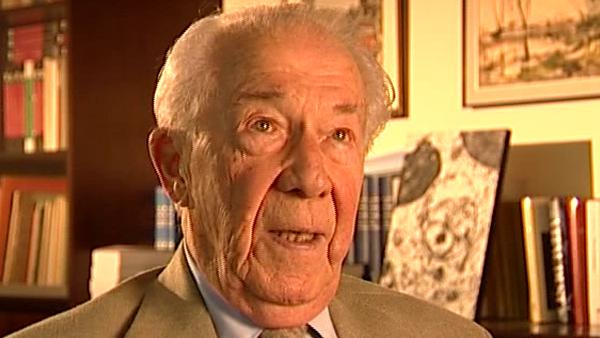NEXT STORY

Using Jesuit logic to solve a problem
RELATED STORIES

NEXT STORY

Using Jesuit logic to solve a problem
RELATED STORIES


|
Views | Duration | |
|---|---|---|---|
| 31. Using centrifugal fractionation to locate enzymes | 162 | 03:29 | |
| 32. The first fractionation experiment | 166 | 03:52 | |
| 33. Surprising results of the first fractionation experiment | 170 | 04:14 | |
| 34. Experiments resulting from the 2nd International Biochemistry... | 143 | 02:21 | |
| 35. Experimenting with phenolphthalein | 118 | 03:08 | |
| 36. George Hogeboom and Walter Schneider | 144 | 04:08 | |
| 37. Using Jesuit logic to solve a problem | 323 | 01:39 | |
| 38. Three possible explanations for our findings | 133 | 02:30 | |
| 39. Acid phosphatase: A new kind of particle | 133 | 06:01 | |
| 40. Experimenting with acid phosphatase | 117 | 04:41 |


We had begun to be really quite fascinated – at least I – with this problem, and so another young man came to join us; he's a man called Berton Pressman. He was an American and he came from a famous lab in Madison, Wisconsin, directed by Henry Lardy – still alive, I think, a very good biochemist – and Berton Pressman had... he was rather a brash young man with not the best of manners, I might say. And so he came to the lab; the first thing he said was: ‘You do this wrong, you do that wrong.’ And he started to change the way we prepared distilled water, the way we measure pH, and so on. But he was a good biochemist and so he measured another enzyme that, this time, I had found in the literature could possibly also behave in the same manner as I mentioned. And that enzyme was cathepsin D, a proteolytic enzyme. And, again, it showed the same properties of latency as the other, so we had three enzymes. Now, I have to go back to the actual fractionation, and maybe this is a good point... a good time to mention something that I forgot to mention when I discussed the techniques. That is: we did not exactly follow Claude's techniques because in the meantime his technique had been modified by a young American co-worker called Walter Schneider. Actually, Walter Schneider and another American biochemist, George Hogeboom, had worked with Claude – they were some of this first co-workers at the Rockefeller – and when they left Rockefeller they had been the main pioneers in the United States and, in fact, in the world of the application of centrifugal fractionation to the study of the localisation of enzymes, basically in liver at that time. George Hogeboom unfortunately died quite young, I think – in '56 or something like that – because he was an extremely gifted investigator and I'm sure he would have done wonders. But they were really the experts in the field and they had changed... Walter Schneider had actually changed Claude's technique; they had introduced isotonic sucrose as medium instead of the saline that was used by Claude, which was very useful because saline was... caused the agglutination of the particles much more than the sucrose and then they also introduced a more... a more gentle and more efficient grinding technique using the homogeniser... the cylindrical glass homogeniser that had been developed at Wisconsin by Potter... Potter and Elvehjem. So that's what the technique that we used at that time, and I'm mentioning this because Hogeboom and Schneider had started several years earlier, studying quite a number of enzymes, so by the time we were doing our work we already knew about some results of various enzymes, and you will see that this is important.
Belgian biochemist Christian de Duve (1917-2013) was best known for his work on understanding and categorising subcellular organelles. He won the Nobel Prize in Physiology or Medicine in 1974 for his joint discovery of lysosomes, the subcellular organelles that digest macromolecules and deal with ingested bacteria.
Title: George Hogeboom and Walter Schneider
Listeners: Peter Newmark
Peter Newmark has recently retired as Editorial Director of BioMed Central Ltd, the Open Access journal publisher. He obtained a D. Phil. from Oxford University and was originally a research biochemist at St Bartholomew's Hospital Medical School in London, but left research to become Biology Editor and then Deputy Editor of the journal Nature. He then became Managing Director of Current Biology Ltd, where he started a series of Current Opinion journals, and was founding Editor of the journal Current Biology. Subsequently he was Editorial Director for Elsevier Science London, before joining BioMed Central Ltd.
Tags: Potter-Elvehjem, Berton Pressman, Henry Lardy, Albert Claude, Walter Schneider, George Hogeboom
Duration: 4 minutes, 8 seconds
Date story recorded: September 2005
Date story went live: 24 January 2008